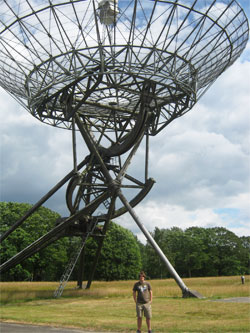
Building on his Macalester research, senior John Allan probed galaxies with the Netherlands Institute for Radio Astronomy—ASTRON.
John Allan ’11
Portland, Oregon
Physics (astronomy emphasis), Religious Studies
 Special interest: Astrophysics
Special interest: Astrophysics
Research: The HALOGAS project at the Netherlands Institute for Radio Astronomy
Radio astronomy: Unlike optical astronomy, which looks at visible light, radio astronomy looks at sources of radio emission in the universe. Optical wavelengths vary between 400 and 700 nanometers, while the radio regime studies wavelengths from millimeters to tens of meters. Radio astronomy uses either single dishes such as the Arecibo telescope, or arrays of dishes such as the Very Large Array in New Mexico or the Westerbork telescope in the Netherlands.
How galaxies form: Galaxies grow by two main methods: colliding and merging with other galaxies or pulling in hydrogen gas and small objects from between galaxies. We currently have a rather poor understanding of how prevalent the latter method is, and how it typically works. Do galaxies just accrete diffuse hydrogen gas, or do they mainly absorb dwarf galaxies? How common is it for a large spiral galaxy to have numerous small gas clouds around it in its outer “halo”? I studied the galaxy NGC 1003, a spiral galaxy 35 million light years distant, looking for small outlying clouds, trails of gas, companion dwarf galaxies, and other evidence of accretion.
How Macalester prepared me: The summer after my sophomore year I did a radio astronomy summer internship with my Macalester advisor, Professor John Cannon. That research experience familiarized me with the way that radio astronomy works, some of the programs used to analyze and reduce data, and helped me develop my physical intuition about galaxy dynamics and my ability to interpret radio data.
Allan’s advice: Never choose a career without trying it out first. Even though there were some frustrating aspects of the research, most of the time it didn’t feel like work. It felt like science!
November 4 2010
Back to top




